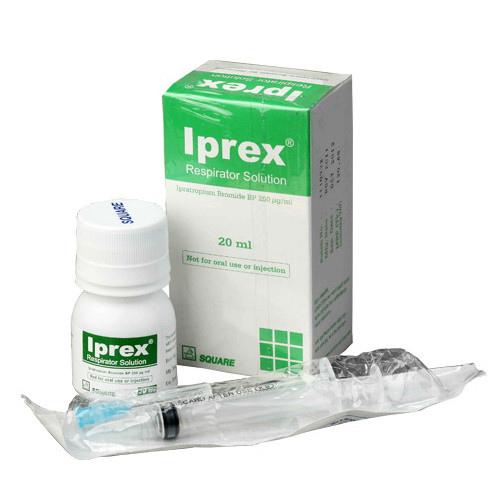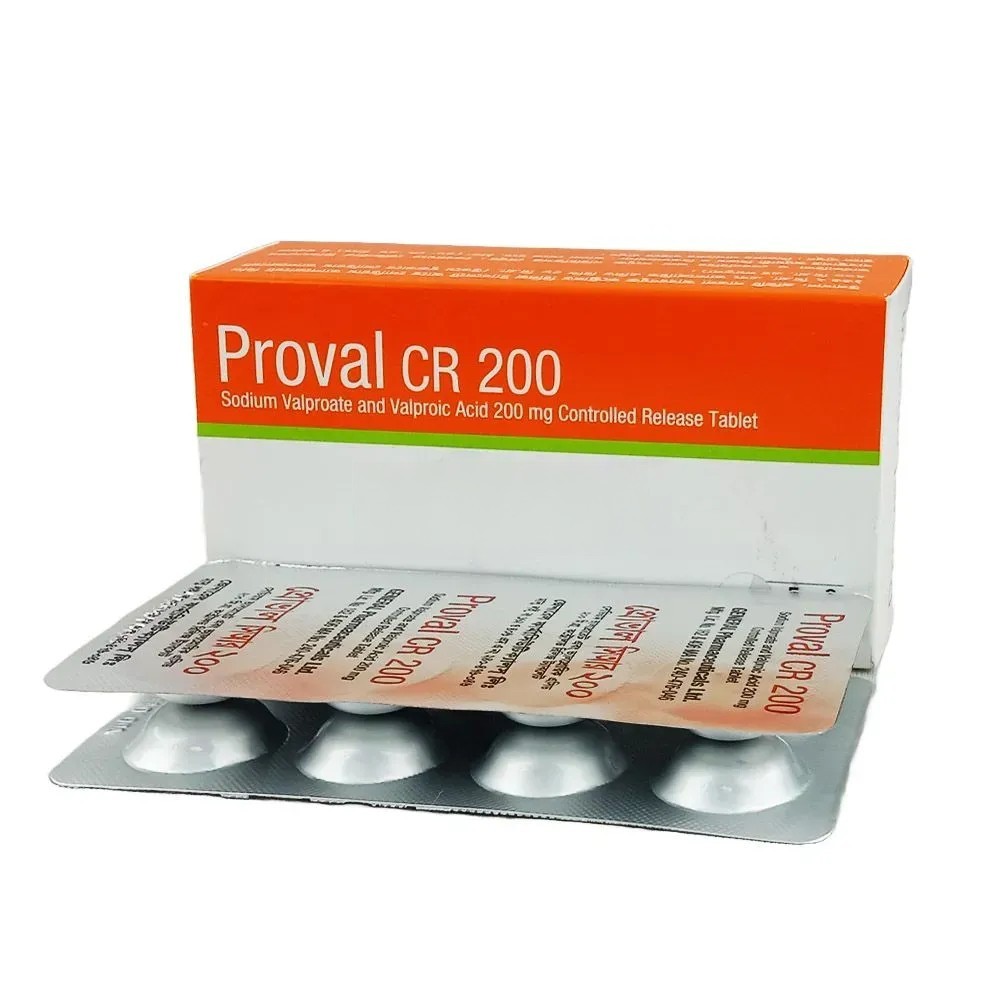

Iprex Nebuliser Solution 20ml, Ipratropium Bromide 250 mcg/ml
Inhouse product
-
৳11.40
৳12.00 -
৳42.75
৳45.00 -
৳16.63
৳17.50 -
৳2.14
৳2.25
Reviews & Ratings
Indications
Nebuliser Solution: It is indicated for the treatment of
reversible bronchospasm associated with chronic obstructive pulmonary disease
(COPD). It is also indicated, when used concomitantly with inhaled beta
2-agonists, for treatment of reversible airway obstruction as in acute and
chronic asthma.
Inhaler: As bronchodilator in the treatment of
chronic reversible airway obstruction as in asthma and chronic obstructive
pulmonary disease including chronic bronchitis and emphysema. Treatment of
acute reversible airway obstruction.
* রেজিস্টার্ড চিকিৎসকের পরামর্শ মোতাবেক ঔষধ সেবন করুন'
Pharmacology
Ipratropium Bromide is
a quaternary ammonium compound with anticholinergic properties. It appears to
inhibit vagal reflexes by antagonising the action of acetylcholine (the
transmitter agent released from the vagus nerve). Anticholinergics prevent the
increase in intracellular concentration of cyclic guanosine monophosphate
(cyclic GMP) caused by interaction of acetylcholine with the muscarinic
receptor on bronchial smooth muscle.
Dosage
Nebuliser Solution-
Adults
(including the elderly) and children over 12 years of age: 250-500 micrograms (i.e. 1 ml or 2 ml) 3 to
4 times daily.
For treatment of acute
bronchospasm: 500 micrograms/2 ml.
It is advisable not to exceed the recommended daily dose during either acute or
maintenance treatment. Daily doses exceeding 2 mg in adults and children over
12 years of age should only be given under medical supervision.
Children 6-12 years of
age: 250 micrograms (i.e.
1 ml) up to a total daily dose of 1 mg (4 ml). The time interval between doses
may be determined by the physician.
Children 0-5 years of
age (for treatment of acute asthma only): 125-250 micrograms (i.e. 0.5 ml-1 ml) up to a total daily dose
of 1 mg (4 ml). Ipratropium bromide should be administered no more frequently
than 6 hourly in children under 5 years of age. Repeated doses can be
administered until the patient is stable. The time interval between the doses
may be determined by the physician.
Ipratropium Nebuliser Solution may be combined with a short-acting beta
2-agonist in the same nebulizer chamber. The solution should be used as soon as
possible after mixing and any unused solution should be discarded. Ipratropium
Nebuliser Solution can be administered using a range of commercially available
nebulizing devices. The dose of nebulizer solution may need to be diluted in
order to obtain a final volume suitable for the particular nebulizer being used
(usually 2-4 ml); if dilution is necessary use only sterile sodium chloride
0.9% solution. The unit dose Ipratropium Nebulizer Solution is intended only for
inhalation with suitable nebulizing devices and should not be taken orally or
administered parenterally.
Inhaler-
Adults: The usual dose is 1-2 puffs (20 gm/spray)
three or four times daily. Single dose upto 80 gm (4 puffs) may be required to
obtain maximum benefit during early treatment. Patients may take additional
inhalations as required; however, the total number of inhalations should not
exceed 12 in 24 hours.
Children:
- 6-12 years: Usually 1-2 puffs
two to three times daily.
- Below 6 years: The usual dose
is 1 puff (20 gm) three times daily.
- In order to ensure that the
inhaler is used correctly, the administration should be supervised by an
adult.
- No specific information on the
use of the product in the elderly is available. Clinical trials have included
patients over 65 years and no adverse reactions specific to this age group
has been reported.
* রেজিস্টার্ড চিকিৎসকের পরামর্শ মোতাবেক ঔষধ সেবন করুন'
Administration
Using an Inhaler seems
simple, but most patients do not know how to use it in the right way. If the
Inhaler is used in the wrong way, less medicine can reach the lungs. Correct
and regular use of the Inhaler will prevent or lessen the severity of asthma
attacks.
Following simple steps can help to use Inhaler effectively (According to
"National Asthma Guidelines for Medical Practitioners" published by
Asthma Association):
- Take off the cap.
- Shake the inhaler (at least six
times) vigorously before each use.
- If the inhaler is new or if it
has not been used for a week or more, shake it well and release one puff
into the air to make sure that it works.
- Breathe out as full as
comfortably possible & hold the inhaler upright.
- Place the actuator into mouth
between the teeth and close lips around the mouthpiece.
- While breathing deeply and
slowly through the mouth, press down firmly add fully on the canister to
release medicine.
- Remove the inhaler from mouth.
Continue holding breath for at least for 10 seconds or as long as it is
comfortable.
- If doctor has prescribed more
than one inhalation per treatment, wait 1 minute between puffs
(inhalations). Shake the inhaler well and repeat steps 4 to 7.
- After use, replace the cap on
the mouthpiece. After each treatment, rinse mouth with water.
- Check your technique in front
of a mirror from time to time, if you see a white mist during the
inhalation, you may not have closed your lips properly around mouthpiece,
or you may not be breathing in as you press the can. This indicates
failure of technique. If this happens, repeat the procedure from step 4
carefully.
Instructions for
Cleaning Inhaler: Clean your Inhaler
at least once a week. Remove canister and rinse the plastic actuator and cap in
warm water but do not put the metal canister into water. Dry the actuator and
cap thoroughly and gently replace the metal canister into the actuator with a
twisting motion. Put the cap on the mouthpiece.
* রেজিস্টার্ড চিকিৎসকের পরামর্শ মোতাবেক ঔষধ সেবন করুন'
Interaction
Inhaler: Iprex has been used concomitantly with other
drugs, including sympathomimetic bronchodilators, methylxanthines, steroids and
cromolyn sodium, commonly used in the treatment of chronic obstructive
pulmonary disease, without adverse drug reactions. There are no studies fully
evaluating the interaction effects of Iprex and these drugs with respect
to effectiveness.
Contraindications
Nebuliser Solution: Known hypersensitivity to atropine or its
derivatives, or to any other component of the product.
Inhaler: Known hypersensitivity to Ipratropium,
Atropine or its derivative. Also contraindicated in patients with a history of
hypersensitivity to soya lecithin or related food products such as soybean,
lecithin and peanut.
Side Effects
Nebuliser Solution:
- Common: Headache, Dizziness, Cough, Inhalation induced
bronchospasm, Dryness of mouth, Vomiting.
- Uncommon: Urticaria, Tachycardia, Skin rash, Pruritus. Rare:
Anaphylactic reaction, Eye pain, Mydriasis, Intraocular pressure
increased, Palpitations, Atrial fibrillation, Nausea.
Inhaler:
- Potentially
life-threatening effects-
Idiosyncratic reactions to Iprex are rare. Severe adverse effects due to
the inhibition of muscarinic receptors and ganglion blockade are
theoretically possible but unlikely with the metered-dose aerosol.
- Severe/Irreversible
adverse effects- No effects of this kind is
reported.
- Symptomatic
adverse effects- Regular use of Iprex can lead
to a dry mouth through inhibition of salivary low.
- Observed during
clinical practice- The most
common adverse reactions reported are dryness of the oropharynx (5%);
cough, exacerbation of symptoms, & irritation from aerosol (3%);
headache (2%); nausea, dizziness, blurred vision/difficulty in
accommodation & drying of secretions (1%). Less frequently reported
adverse reactions to include tachycardia, nervousness, paresthesias,
drowsiness, coordination difficulty, itching, hives, flushing, alopecia,
constipation, tremor & mucosal ulceration. Case of precipitation or
worsening of narrow-angle glaucoma, acute eye pain & hypotension have
been reported. Allergic-type reactions such as skin rash, angioedema of
the tongue, lips & face, urticaria (including giant urticaria),
laryngospasm and anaphylactic reactions have been also reported; with
positive rechallenges in some cases. Iprex does not produce adverse
effects on mucociliary clearance, in contrast to atropine and other
muscarinic antagonists. There is no evidence that in the therapeutic dose
range, Iprex has any adverse effect on bronchial secretion.
Pregnancy & Lactation
The safety of
Ipratropium Nebulizer Solution during human pregnancy has not been established.
The benefits of using Ipratropium Nebuliser Solution during pregnancy must be
weighed against the possible hazards to the fetus. It is not known whether
ipratropium bromide is excreted into breast milk. Caution should be exercised
when Ipratropium Nebulizer Solution is administered to nursing mothers.
Precautions & Warnings
Nebuliser
Solution: Use of the nebulizer
solution should be subject to close medical supervision during initial dosing.
Caution is advocated in the use of anticholinergic agents in patients with
narrow-angle glaucoma, or with prostatic hyperplasia or bladder-outflow
obstruction or cystic fibrosis. Immediate hypersensitivity reactions have been
demonstrated by rare cases of urticaria, angioedema, rash, bronchospasm,
oropharyngeal edema and anaphylaxis. There have been isolated reports of ocular
complications (i.e. mydriasis, increased intraocular pressure, narrow-angle
glaucoma, eye pain) when aerosolized Iprex has come into contact with the eyes
during nebulizer therapy.
- Patients must be instructed in
the correct administration of the Iprex Nebulizer Solution.
- Care must be taken not to allow
the solution or mist to enter the eyes.
- It is recommended that the
nebulizer solution is administered via a mouthpiece.
- If a mouthpiece is not
available and a nebulizer mask is used, it must fit properly.
Inhaler: Patients should be advised that temporary
blurring of vision precipitation or worsening of narrow-angle glaucoma or eye
pain may result if the aerosol is sprayed into the eyes. If recommended dosage
does not provide relief or symptoms become worse, patients should seek
immediate medical attention. While taking
Iprex inhalation aerosol, other inhaled drugs should not be used unless
prescribed.
Iprex inhalation aerosol is not indicated for the initial treatment of acute
episodes of bronchospasm where rapid response is required. Drugs with faster
onset may be preferable as initial therapy in this situation. Immediate
hypersensitivity reactions may occur after administration of Iprex, as
demonstrated by rare cases of urticaria, angio-oedema, rash, bronchospasm and
oropharyngeal oedema.
Overdose Effects
Acute overdosage by
inhalation is unlikely since Iprex is not well absorbed systematically after
aerosol administration. Inhaled dosage of 5 mg produces an increase in heart
rate and palpitation. Single doses of Iprex 30 mg by mouth caused
anticholinergic side effects but which were not considered severe enough to
require specifc reversal.
Therapeutic Class
Anticholinergic
bronchodilators
Storage Conditions
As the product
contains no preservative, a fresh ampoule should be used for each dose and the
ampoule should be opened immediately before administration. Any solution left
in the ampoule should be discarded. Do not store above 25°C. Keep the ampoule
in the outer carton.
Frequently Bought Products
Fix-A Capsul, Cefixime Trihydrate 200 mg
Gelora Oral Gel 15gm tube, Miconazole Nitrate 2% w/w
Olistat Capsule, Orlistat 120 mg
Nexum MUPS MUPS Tablet, Esomeprazole 20 mg
Product Queries (0)
Login Or Registerto submit your questions to seller
Other Questions
No none asked to seller yet
-
৳11.40
৳12.00 -
৳42.75
৳45.00 -
৳16.63
৳17.50 -
৳2.14
৳2.25













![Evit Capsule, Vitamin E [Alpha Tocopherol Acetate] 200 mg](https://skpharma.com.bd/public/uploads/all/Qb6ltONrVNuXs9S2dknULU0kveuA88FdO5ZOLtVH.webp)

![Germicord Topical Solution 10ml, Chlorhexidine Gluconate [7.1%] 7.1%](https://skpharma.com.bd/public/uploads/all/XrFTw3u4m7EhIElgaR3K3BQk86EaevfW5h9fO0Gg.webp)

